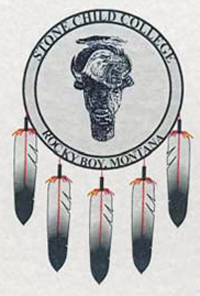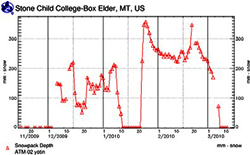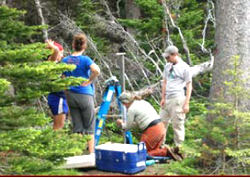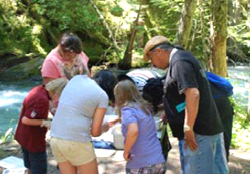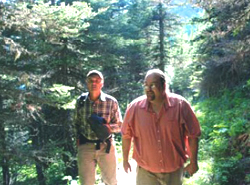Stars and STEM Stories
Stone Child College Leads GLOBE Tribal Initiatives
A GLOBE Partner since 2001, tribally-controlled community college Stone Child College (SCC) of the Chippewa-Cree Tribe offers degree and certificate programs of study. Located in Box Elder, Montana, the college primarily fulfills the educational needs of the Rocky Boy's Indian Reservation. This GLOBE Partnership, along with Stone Child College's instructional program, educates students in the STEM (Science, Technology, Engineering and Mathematics) education areas; particularly through their Natural Resource program. SCC integrates GLOBE Protocols into various realms of the undergraduate curriculum such as atmospheric science, ecology, GPS principles and practices, soil science, statistics, and undergraduate research. The GLOBE Program activities also support Stone Child's Science, Technology, Engineering, and Mathematics (STEM) department's priority initiatives in promoting, preserving, and researching the Chippewa-Cree culture and language.
SCC Math Instructor Eric Shulund employs creative methods to elicit student participation in his own personal love and enjoyment of math. Shulund's statistics class recently spent hours navigating the GLOBE Database, pulling meteorological data from SCC's ongoing Atmosphere research. Students used the information to create and analyze spreadsheets containing graphs and summary statistics of their project data, which included GLOBE temperature data for the month of January each year from 2003-2010. Temperatures recorded at the SCC GLOBE weather station revealed January 2010 as one of the coldest since the project began, second only to January 2008. Both 2008 and 2010 produced average maximum temperatures below 0 degrees Celsius. January 2006 contained the warmest temperatures, with the average minimum significantly exceeding the average maximum for January 2008.
In addition to measuring winter temperatures, SCC students study the impact of the harsh conditions of ice and snow cover as major factors in climate modeling. Using GLOBE's Solid Precipitation Protocol, students have monitored snowfall and total snowpack, recording snow depth and creating charts that compare each of the winter months over a seven-year period of data collection. Data gathered during the winter of 2009 showed two extended periods of snow cover, separated by merely a 10-day period of no ground accumulation. The least amount of snow cover transpired in 2005, with the maximum occurring in 2006, at a total snow depth of 497 millimeters.
Instructors integrate GLOBE Hydrology and Soil Protocols in order to provide a well-rounded, hands-on approach to science education. In July 2009, Geoscience Instructor Antony Berthelote led a hike to Lake Josephine in Glacier National Park, West Glacier, Montana for undergraduate students; during the excursion, students engaged in reconstructing past environmental conditions using the processes of lake coring and radio-carbon dating. The following day, students toured the park, learning the history and geology of the area. The tour concluded with a GLOBE Hydrology Training at Mission Falls in the mountains east of St. Ignatius.
SCC participates in a United State Department of Agriculture (USDA) Agriculture Research Project, which requires the use of GLOBE Soil Protocols. Students set up recording sites to measure soil moisture at four different depths. According to SCC Natural Resource/GIS Instructor Douglas Krebs, "We just completed the calibration curves for the two soil moisture sites. The sites are called Mahtahmin-1 and Mahtahmin-2. Mahtahmin means ‘corn' in Cree." Learn the meanings of other Cree words at the Bear Paw GLOBE Academy Credo website. Each month, the Tribal Colleges and Universities Project (TCUP) releases a newsletter, TCUP Times, that summarizes GLOBE related activities, including a graph showing the previous month's average maximum, average minimum, and current temperatures for that month each year since 2003. According to TCUP Times, objectives of the TCUP Project include: recruiting and retaining 24 students per year in STEM disciplines; developing a research agenda, which coincides with needs of the reservation community; developing new and innovative curriculum in STEM areas; developing culturally based STEM materials; strengthening SCC's technological infrastructure; and developing SCC's capacity to deliver online coursework. GLOBE resources are an integral part of generating curriculum and engaging students in STEM based research at both a local and global level.
SCC is one of many colleges involved in the GLOBE community effort to increase outreach to Tribal Schools. In August 2001 GLOBE initiated a national effort to work with Tribal Colleges through the Weaving Common Threads GLOBE training in Flagstaff, AZ. Tribal Colleges represented included Stone Child, Dine'-Shiprock, Little Big Horn, Salish Kootenai, Dull Knife, Blackfeet Community, Fort Peck, and Fort Belknap Colleges of Montana; Crownpoint Institute of Technology of New Mexico; Haskell Indian Nations University of Kansas; and White Earth Tribal & Community College of Minnesota. The Challenger Learning Center of Alaska, University of Alaska-Fairbanks, the Institute of Tribal Environmental Professionals at NAU, and the Hawaii Department of Education also took part in the sessions. The training event focused around GLOBE implementation within the framework described in the Handbook for Culturally Responsive Curriculum published by the Alaska Science Consortium and the Alaska Rural Systemic Initiative. Follow-up efforts continue to be a priority.
GLOBE is working with NASA Langley Research Center's Native American Liaison to expand outreach efforts for our Tribal communities. Another initiative is underway to expand GLOBE into the schools on Reservations in the Northern Great Plains through the Northern Great Plains Tribal Digital Village. In addition, initiatives have begun with Sinte Gleska University in Mission, South Dakota, and the team from the Native American Activities Work Managers at USGS and EROS Data Center in Sioux Falls, South Dakota. GLOBE and NativeView are also discussing collaborative connections which include the SATELLITES project from the University of Toledo GLOBE Partnership and OhioView.
GLOBE participated as a Partner in NASA's Life Long Learning Online — The Lewis and Clark Rediscovery Project (L3) between the University of Idaho, Wheeling Jesuit University and the University of Montana to create a resource highlighting Tribal involvement with the Lewis and Clark expedition commemoration. The project worked with GLOBE from the beginning stages to include the GLOBE program protocols as a means of looking at the past through the Lewis and Clark journals and comparing these documents to the present using GLOBE student-gathered data. Currently, an extensive follow-up effort is underway by U.S. Partners, including GLOBE Tribal Partners, to promote GLOBE activities along the Lewis and Clark Trail.
12 November 2010






